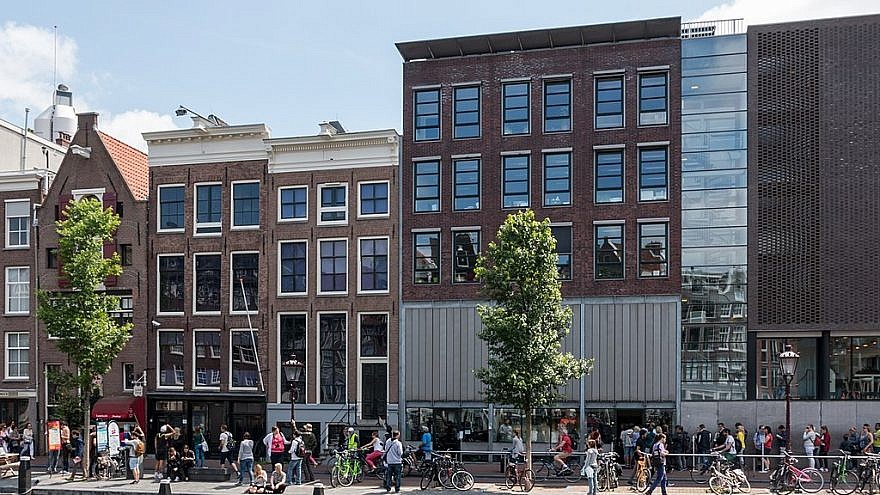Of all the places on earth, the Anne Frank House in Amsterdam prohibited its Jewish employees from wearing kipot, head coverings worn by observant Jews that are also referred to as yarmulkes. The outrageous policy was changed only recently after a local media outlet intervened.
It all began when Barry Vingerling, a 25-year-old Dutch Jew, began working at the museum. He told NIW, the local news website for Jews and Israelis in Holland, that a while after he began working there he started wearing a kipah and was promptly asked by the museum directors to remove it.
Of all the places on earth, the Anne Frank House in Amsterdam prohibited its Jewish employees from wearing kipot, head coverings worn by observant Jews that are also referred to as yarmulkes. The outrageous policy was changed only recently after a local media outlet intervened.
It all began when Barry Vingerling, a 25-year-old Dutch Jew, began working at the museum. He told NIW, the local news website for Jews and Israelis in Holland, that a while after he began working there he started wearing a kipah and was promptly asked by the museum directors to remove it.
Subscribe to The JNS Daily Syndicate by email and never miss our top stories
The museum’s policy, Vingerling was told, was that religious symbols of any kind must be concealed from visitors to the museum (Dutch law applies to all public institutions in the country).
“I was stunned by the demand to take off the kipah,” Vingerling told NIW. “Here of all places, where Anne Frank was forced to hide because of her identity, I have to hide my Jewish identity?”
Vingerling said he reported the case to his superiors, who told him the matter was being addressed. An answer, however, never came. Meanwhile, at his request, Vingerling was promised that the museum’s board of directors would convene an official discussion on the matter in October 2017, but it has since been delayed until May 15.
Vingerling then turned to Rabbi Menno ten Brink, who serves on the museum’s advisory board. Brink’s answer, however, left him equally dumbfounded.
“He said there was no halachic [Jewish law] problem with wearing a hat over a kipah, and suggested I wear the hats provided by the museum, which say ‘Anne Frank House,’ ” he related.
Vingerling said he understands the policy pertaining to public places in Holland, but believes the Anne Frank House is not the right place to insist on it. “It was explained to me that the policy is to allow for as many people as possible to visit the Anne Frank House, and therefore any expression of religion or politics are undesirable there. With that, I have a hard time understanding how the museum for Anne Frank, who was Jewish, which demonstrates the consequences of prejudice and intolerance, behaves in the same manner.”
On April 2, NIW contacted the Anne Frank House for a response, as well as the Anne Frank Foundation in Basel, Switzerland.
One foundation official told NIW that any policy forbidding the wearing of kipot at the Anne Frank House was unacceptable. From there, matters began to snowball quickly. The board of directors meeting to discuss the matter, originally postponed to May 15, was rescheduled for the next day, April 3, after which a foundation representative told Vingerling that the board had decided to allow him to wear a kipah at work.
“It may have taken six months, but this was very important to me,” stressed Vingerling. “This isn’t only about my fight with the board of directors; it’s something the entire Jewish community needs to hear about.”
The Anne Frank Foundation issued the following statement: “Until recently we didn’t have a policy on this matter. … About six months ago we first received a request from an employee [Vingerling] to wear a kipah. The Anne Frank House’s code of conduct stipulates that employees who work at the museum must be identifiable to visitors and wear the relevantly marked attire.
“As a result of the employee’s request to wear a kipah, the need for a policy discussion on this matter was raised. This is an important issue, which was discussed with various departments in the organization. … This takes a little while. In the meantime, on the basis of additional inquiry and following consultation with the [museum’s] management and members of the supervisory council, we decided to allow religious symbols to be worn in the museum and at the Anne Frank House store.”
The museum’s policy, Vingerling was told, was that religious symbols of any kind must be concealed from visitors to the museum (Dutch law applies to all public institutions in the country).
“I was stunned by the demand to take off the kipah,” Vingerling told NIW. “Here of all places, where Anne Frank was forced to hide because of her identity, I have to hide my Jewish identity?”
Vingerling said he reported the case to his superiors, who told him the matter was being addressed. An answer, however, never came. Meanwhile, at his request, Vingerling was promised that the museum’s board of directors would convene an official discussion on the matter in October 2017, but it has since been delayed until May 15.
Vingerling then turned to Rabbi Menno ten Brink, who serves on the museum’s advisory board. Brink’s answer, however, left him equally dumbfounded.
“He said there was no halachic [Jewish law] problem with wearing a hat over a kipah, and suggested I wear the hats provided by the museum, which say ‘Anne Frank House,’ ” he related.
Vingerling said he understands the policy pertaining to public places in Holland, but believes the Anne Frank House is not the right place to insist on it. “It was explained to me that the policy is to allow for as many people as possible to visit the Anne Frank House, and therefore any expression of religion or politics are undesirable there. With that, I have a hard time understanding how the museum for Anne Frank, who was Jewish, which demonstrates the consequences of prejudice and intolerance, behaves in the same manner.”
On April 2, NIW contacted the Anne Frank House for a response, as well as the Anne Frank Foundation in Basel, Switzerland.
One foundation official told NIW that any policy forbidding the wearing of kipot at the Anne Frank House was unacceptable. From there, matters began to snowball quickly. The board of directors meeting to discuss the matter, originally postponed to May 15, was rescheduled for the next day, April 3, after which a foundation representative told Vingerling that the board had decided to allow him to wear a kipah at work.
“It may have taken six months, but this was very important to me,” stressed Vingerling. “This isn’t only about my fight with the board of directors; it’s something the entire Jewish community needs to hear about.”
The Anne Frank Foundation issued the following statement: “Until recently we didn’t have a policy on this matter. … About six months ago we first received a request from an employee [Vingerling] to wear a kipah. The Anne Frank House’s code of conduct stipulates that employees who work at the museum must be identifiable to visitors and wear the relevantly marked attire.
“As a result of the employee’s request to wear a kipah, the need for a policy discussion on this matter was raised. This is an important issue, which was discussed with various departments in the organization. … This takes a little while. In the meantime, on the basis of additional inquiry and following consultation with the [museum’s] management and members of the supervisory council, we decided to allow religious symbols to be worn in the museum and at the Anne Frank House store.”


























